Ash trees began dying in 2001 in Detroit, and no one could say why. Then glittering green beetles were discovered crawling out of an ash log.
American scientists had never seen these beetles. They reached out to experts around the world for help. A Slovakian entomologist named Eduard Jendek solved the mystery: Detroit's ash trees were being killed by Agrilus planipennis, the emerald ash borer, an obscure species native to eastern Asia.
In its home forests, the emerald ash borer causes little trouble. That is not the case in North America. The emerald ash borer has spread north through Canada, south to the Gulf of Mexico, east to the Atlantic and as far west as Colorado. In Arkansas, the borer has been confirmed in six counties, and the Arkansas Forestry Commission has placed a quarantine on them and on 19 buffer counties. In a review published last year, scientists called it "the most destructive and economically costly forest insect to ever invade North America."
Scientists are scrambling to find ways to stop the beetle. Some are testing insecticides; others are trying to quarantine healthy forests. But recent research suggests the key may be found in the trees themselves, in the chemicals they use to battle insects.
Insects are dread enemies of any tree species. They may strip away the leaves, so that a tree can no longer harvest sunlight. They may destroy its trunk or lay waste to its roots, so it can no longer take in water.
To defend themselves, trees depend mostly on chemistry, manufacturing compounds that make their tissues tough to digest or their wood and leaves poisonous. Trees produce some defensive chemicals, called constitutive compounds, pretty much all the time. But trees also create a fresh supply of other insect killers, called inducible compounds, when they sense an attack.
In eastern Asia, ash trees have evolved defenses against local insects like the emerald ash
borer. To study their adaptations, scientists have grown eastern Asian species, such as the Manchurian ash, in greenhouses and experimental fields. They allow emerald ash borers to attack the trees, and then observe how the trees fight back.
In the journal New Phytologist in August, researchers at Ohio State University summarized what scientists have been learning from these experiments in the review article "Progress and gaps in understanding mechanisms of ash tree resistance to emerald ash borer, a model for wood-boring insects that kill angiosperms."
When a female emerald ash borer searches for a tree in which to lay her eggs, she avoids healthy Manchurian ash trees, much preferring a North American ash or a Manchurian ash weakened by drought. As it turns out, a healthy Manchurian ash is a hostile place for beetle progeny. When an emerald ash borer's eggs hatch in these trees, the larvae struggle to survive.
This may be why the beetle never caused much alarm: In eastern Asia, it left healthy ashes alone. "It's going to kill already dying trees," said Caterina Villari, a postdoctoral researcher at Ohio State and an author of the review.
Villari and her colleagues don't know precisely how drought makes Manchurian ash trees vulnerable to the insects. Drought-stricken trees appear to produce constitutive compounds in the same amounts as healthy trees, but not some of the insect-killing inducible compounds.
By contrast, even a healthy North American ash can fall prey to the emerald ash borer. North American ashes can fend off local enemies, but the emerald ash borer presents a new challenge, one they haven't evolved to meet.
To understand that failure, Villari and her colleagues have been comparing the defenses of Manchurian ashes with those of North American species like white ash and blue ash. The researchers have identified an assortment of chemicals that Manchurian ash trees make in higher amounts.
"The fact that Manchurian ash had a higher concentration of one particular compound doesn't mean that compound is what makes it resistant," Villari said. "It's a first step."
North American ashes may be dying not because they lack a magic antidote against emerald ash borers, but because they may not be producing defensive chemicals in the right balance -- or perhaps they just aren't making them fast enough.
HURRY UP
In one relevant experiment, Justin G.A. Whitehill of the University of British Columbia and his colleagues were able to get North American ashes to fight off the beetles. To do so, the researchers sprayed the trees with a plant hormone called methyl jasmonate. That hormone is released by plant cells that are damaged by chewing insects. It acts as an alarm, prompting the entire plant to make inducible compounds.
Whitehill and his colleagues reported last year that when they primed North American ash trees with the hormone, the plants killed off many emerald ash borers. The effect was about as strong as a lethal dose of insecticide.
Now researchers are hoping that one day they will be able to identify ash trees making high levels of key chemicals and to breed them into resistant stocks. Scientists could be able to pick out trees that respond with unusual speed to an emerald ash borer attack.
In the real world, North American ash trees fail to deliver this powerful punch. It's possible that they don't recognize the beetles as a special threat, so they fail to mount a swift response.
New studies are underway to make sense of these tantalizing results. Unfortunately, running experiments on trees is not for the impatient. The science is moving ahead steadily and slowly, but the emerald ash borer is racing for new forests.
ActiveStyle on 09/14/2015

